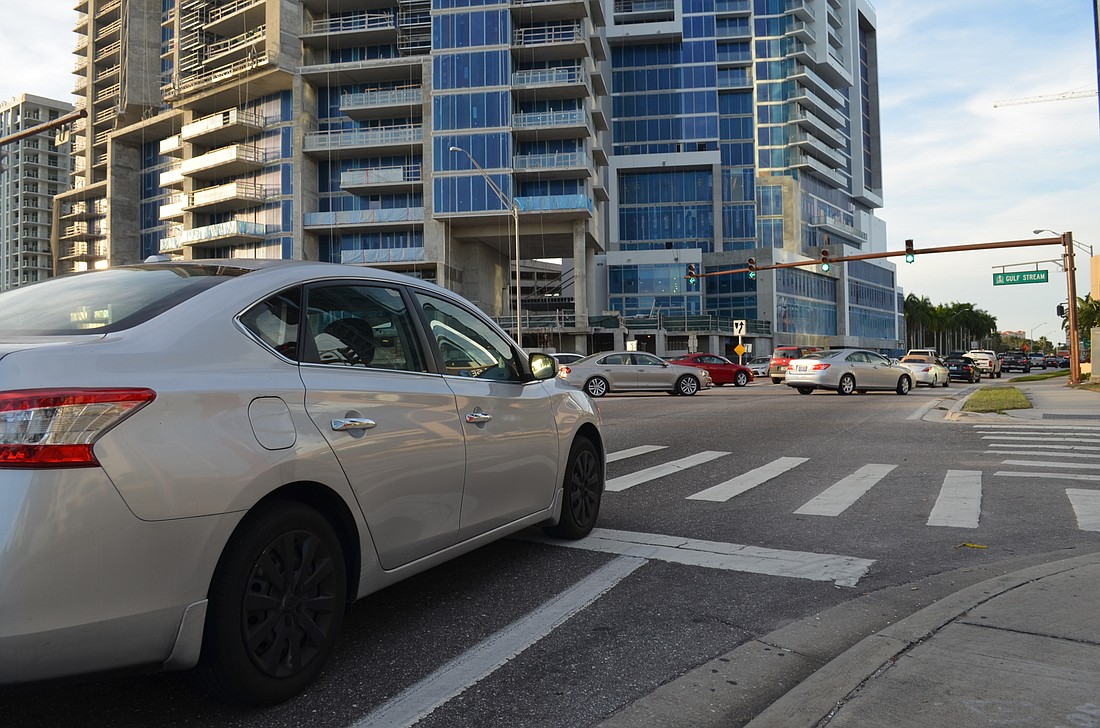- April 26, 2024
-
-
Loading

Loading

If you’re waiting for a fix for all the problems posed by the stretch of U.S. 41 between Fruitville Road and Gulfstream Avenue, City Engineer Alex DavisShaw says you shouldn’t hold your breath.
“You don’t have a perfect solution,” DavisShaw said. “There are pros and cons.”
City and state officials are in the process of sifting through those pros and cons. Last month, the Florida Department of Transportation held a public workshop to discuss potential changes to the intersection of Gulfstream and U.S. 41. Next week, FDOT will hold another meeting focused on Fruitville and U.S. 41.
Nothing is finalized, but the state is considering adding roundabouts to both intersections. This has been a cause for concern for residents skeptical about how drivers would navigate the multilane roundabouts, but state officials have praised the efficacy of the traffic features.
At Saturday’s Coalition of City Neighborhood Associations meeting, one resident brought up a different line of criticism. Lou Costa, a retired engineer living on Bird Key, has worked with city officials on efforts to improve the traffic flow near the John Ringling Causeway.
Costa does believe roundabouts could effectively move traffic through the intersections. But he’s focused on a different element FDOT is considering: a pedestrian-activated signal that would alert oncoming traffic that someone was trying to cross the street.
The pedestrian aids, called hybrid beacons, would alert drivers when a pedestrian has pushed the button and when it is safe to cross again.
Costa said an on-demand pedestrian crossing system will minimize the traffic flow improvements that come with a roundabout.
“Roundabouts are sensitive to traffic stoppages,” Costa said. “It results in gridlock, which we’re trying to eliminate.”
Costa and fellow retired engineer Lou Dorff have come up with an alternate solution: installing pedestrian overpasses on U.S. 41 at Gulfstream and Fruitville.
Costa knows the city and state are trying to solve two problems. Not only does the flow of traffic need to improve, but they also want to make it easier for pedestrians to cross U.S. 41. He said putting in a roundabout and hybrid beacons could produce marginal upgrades in both of those areas, but the improvements would clash with one another and have a muddled effect.
He said a pedestrian bridge could have a more pronounced impact on traffic.
“What we’re trying to do is address both problems, as opposed to one at the expense of the other,” Costa said.
“Roundabouts are sensitive to traffic stoppages. It results in gridlock, which we’re trying to eliminate.” — Lou Costa
DavisShaw said city staff has previously discussed the possibility of building a pedestrian overpass, but the conversation did not reach an advanced stage. There are a few reasons for that.
There are logistical challenges. The city doesn’t have much available right of way along U.S. 41, which would make it difficult to find a landing spot for a pedestrian bridge. Complying with the Americans with Disability Act would be complicated, too — from an engineering perspective if the city built a ramp, or from a cost perspective with an elevator.
In general, funding is a big question mark.
“Looking at some that have been done fairly recently, they have been several million dollars,” DavisShaw said. “We don’t have a funding source for that.”
Beyond all that, there’s no guarantee the bridges would be an effective tool. DavisShaw said pedestrian bridges that work well are typically built around a specific destination, which wouldn’t be the case on U.S. 41.
“In Las Vegas and at New College, there’s a reason why you’re there,” DavisShaw said. “You’re not going there just to cross the street.”
Still, she did say the pedestrian crossing could interfere with the flow of traffic. And there’s at least one supporter of the pedestrian bridge concept: City Manager Tom Barwin, who has suggested the city could use settlement money from the BP oil spill to pay for an overpass.
Costa acknowledges there are steps the city would need to take to ensure the bridges actually get used. Many pedestrians, rather than walking up to a bridge, would opt to just dart across the street when they saw an opening in traffic. Costa said people could be steered toward the bridge if the city installed a raised median on U.S. 41 that made it difficult for people to walk across it.
As for the cost, he said it’s worth it to address a pressing traffic issue. Costa felt he got a positive reception at Saturday’s CCNA meeting, with only one resident questioning whether the pedestrian bridges fit in with the image the city wanted to present.
Costa and Dorff are continuing to press forward with the overpass proposal, confident it’s an option worth considering in a crucial corridor. They’re hopeful local municipalities will join them, reaching out to the state in an effort to advocate for the pedestrian bridges.
DavisShaw said the future of the intersections will be clearer when FDOT produces its recommendations.
Based on the consternation surrounding traffic congestion, Costa believes addressing that issue should be a high priority.
“These junctions between Fruitville and Gulfstream have to be designed in such a way that it does not end up with a choke point for traffic,” he said.